How to Pick the Right Filter for Your Ratio
So many filters, so little time! Here's the quick summary of filter types and the benefits of each. Read on for all the details.
Material:
- Chemex conical filters offer thick paper for ultra-clean extractions
- Able Kone provides a rich French-press-like cup but with more clarity
- Flat bottom basket style offers a crowd-pleasingly familiar middle ground
Geometry:
- Flat-bottomed for consistently well-rounded results
- Conical for the control freaks seeking the perfect extraction.
The sheer number of variables that go into a great cup of coffee can be overwhelming for beginner and aficionado alike. With all the effort we put into choosing the right beans, the right coffee machine, and even the right brewing ratio it can be easy to forget about the filter. What may seem like an entirely perfunctory step in the ritual of making coffee can actually make a massive difference in how your coffee tastes. Just as you carefully pick your favorite beans, your coffee filter of choice deserves consideration, too.
There are two key components to how a coffee filter can change your coffee brewing experience. First, the material of the filter determines what can get through into your cup, directly impacting the flavor and mouthfeel of your coffee. Second, the filter, and in particular its shape, changes how water flows through the ground coffee while brewing which has a number of effects on the brewing process.

Filter Material
When brewing your coffee the filter doesn’t just keep out all those large grounds – though, coffee certainly wouldn’t be quite as pleasant without that service. It’s also filtering out tiny coffee particles and oils which can drastically change the resulting coffee. A great way to conceptualize this is to think back to the last cup of french press coffee you had and compare that to coffee from a paper-filter brewing method. French press coffee is characterized by its rich, thick mouthfeel and is often described as having a more robust flavor.
The reason that, by comparison, your average paper-filtered coffee feels so much cleaner and lighter is that far more of those tiny particles and oils are being filtered out by the fine fabric of the paper filter than by the coarse metal mesh of the French press filter.

With the Ratio Eight you have the option to pick between a paper Chemex filter and a metal Able Kone filter. With the Ratio Six you get the basket style Melitta paper filter as well as the option to to use Chemex and Able Kone filters with the purchase of a Ratio glass carafe or thermal carafe and dripper. Each of these options has their own distinct benefits.
The Chemex filter isn’t just any paper coffee filter, it’s among the thickest produced. If you’ve ever handled one this is immediately apparent, feeling more like construction paper than your traditional tissue-like paper filter. That resemblance is no coincidence: construction paper is essentially what the Chemex’s inventor used when he created it back in 1941. The benefit of this is a notoriously clean and clear cup that has a lighter mouthfeel than just about any other filter can produce.
If you’re more a fan of French-press-style richness and the Chemex filter sounds like the wrong direction, the Able Kone is your new best friend. Like a French press, it uses a metal filter which allows some small solid particles and oils to pass through. Unlike a French press, it uses a high-tech chemical etching process to produce incredibly small holes that are resistant to clogging. This means that you get the benefit of a richer cup without risking the sludginess that can come with French press coffee. To top it off, the Able Kone is also reusable, saving you from having to buy (and throw away) paper filters in perpetuity!
Somewhere between the two you have the Melitta paper filter. This is the option most likely to feel familiar thanks to their ubiquity, and there's a good reason for that ubiquity. The Melitta’s thinness makes it far more porous than the Chemex filter, allowing it to hold back most small particles and oils while still letting some through. The result is a cup that strikes a balance between ultra-clean and French-press-rich that is sure to do justice to any coffee, and please just about any guest.

Filter Shape
Filter shape can have just as big an impact on your brew, though in slightly more subtle ways. The shape of your coffee filter (and brewing vessel) determines how water passes through your ground coffee. The Chemex and Able Kone both have a conical design, whereas the Melitta filter has a flat basket-style design, and each of these geometries have their pros and cons.
The greatest strength of flat bottomed filters is their ability to produce consistent results. Part of the reason for this is the way the brewer around them is designed. The flat bottomed filters are quite thin, and the opening beneath the filter that allows brewed coffee to escape into your pot is relatively small. This means that the small opening at the bottom is what controls the flow rate of water through your coffee. If your coffee is too coarse or too fine, that small opening is still going to control the amount of water that can come out, meaning you don’t have to worry too much about getting things just right. Further, the fact that the water has a greater tendency to fill up in the flat bottomed filter results in a consistently well rounded extraction of flavors from the coffee.

Conical filters trade consistency for control. While the flat-bottomed design makes things relatively foolproof, it also somewhat limits your ability to control your extraction. With a conical filter you’ll find that the opening at the bottom of the brewer is quite large and does essentially nothing to limit the rate at which water can leave the filter. Not only does this mean that the coffee grounds are doing the work of controlling the flow of water, but also that you generally have less water dwelling in the filter at any given time. Now your grind size, and the microscopic shape of those grinds, has a greater impact on the taste of your cup of coffee. With conical you get the greatest ability to control your extraction and the control-freak lifestyle, while sometimes rewarding, just isn’t for everyone.
Between the Chemex filter, Able Kone, and Melitta flat-bottomed filters there’s an option that’s going to excite just about anyone and produce a fantastic cup that suits their taste. With this guide, we hope that you’re able to pick the filter that’s just right for you.
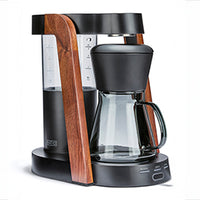 Ratio Eight S2
Ratio Eight S2
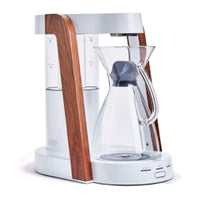 Ratio Eight Original
Ratio Eight Original
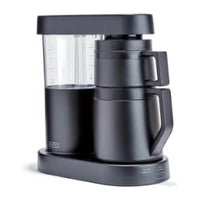 Ratio Six
Ratio Six
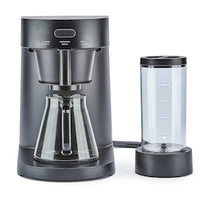 Ratio Four
Ratio Four
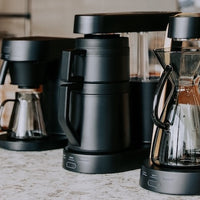 Compare Machines
Compare Machines








